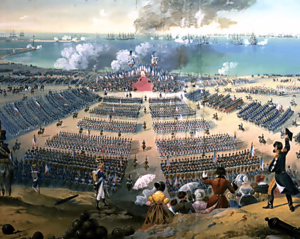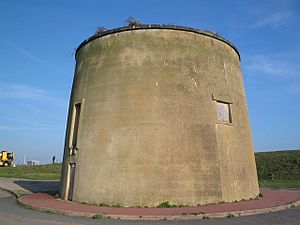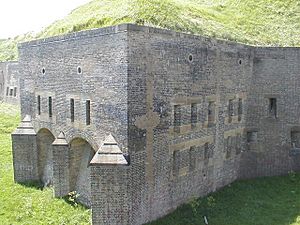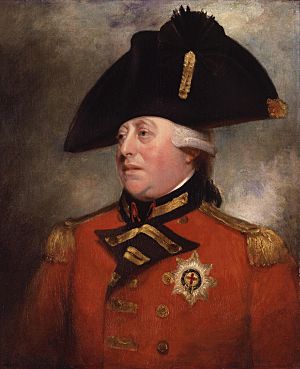British anti-invasion preparations of 1803–05 facts for kids
The British preparations against invasion (1803–1805) were the ways the United Kingdom got ready to defend itself from Napoleon's plan to invade. This included getting a huge number of people involved in the military, more than ever before in Britain. By December 1803, over 615,000 people were part of the armed forces! Many parts of the southern English coast were also made stronger with new forts and gun positions. However, Napoleon never actually tried his invasion, so these preparations were never truly tested in battle.
Contents
Why Britain Prepared for Invasion
After the French Revolution in 1789, Britain and France were almost always at war. This lasted from 1793 to 1802, and then again from 1803 to 1815. There was a short break called the Peace of Amiens from 1802 to 1803.
In 1797, Napoleon, a powerful French leader, said that France needed to "destroy the English monarchy" or risk being destroyed by Britain. He wanted to focus on the navy to defeat England, believing that if England fell, the rest of Europe would follow.
Napoleon decided not to invade Britain right away. Instead, he tried to attack British interests in Egypt, but this failed. In March 1802, Britain and France signed the Treaty of Amiens, which brought a temporary end to the war. However, both the British Prime Minister, Henry Addington, and Napoleon knew the peace wouldn't last. Britain declared war on France again on May 18, 1803. William Pitt later replaced Addington as Prime Minister in May 1804.
In 1803, Napoleon again focused on invading England. He said he wanted a "favourable wind" to plant his "Imperial Eagle" (a symbol of his army) on the Tower of London. This time, Napoleon planned an even bigger invasion. He built a new fleet of ships and gathered his huge army, the Grande Armée, with over 100,000 soldiers at Boulogne, France.
How Britain Mobilized its Armed Forces
Britain had several types of armed forces ready to defend the country.
What was the Regular Army?
The Regular Army was Britain's professional fighting force. During the short peace (the Amiens interlude), Prime Minister Addington's government kept the Regular Army at 132,000 men. About 18,000 of these soldiers were in Ireland, and 50,000 were in Great Britain. The rest were serving in other parts of the world.
What was the Army of Reserve?
In 1803, many of the Regular Army's regiments created a second group of soldiers called the Army of Reserve. To get enough men, 50,000 recruits were chosen by a lottery system within a year. These soldiers could only serve in Great Britain. If they chose to become Regular soldiers, they would get paid extra money. After nine months, fewer than 3,000 of the 42,000 men were from the lottery. The government stopped recruiting for this group because they were still 15,000 men short of their goal.
What was the Militia?
The Militia was a group of infantry soldiers based in different areas. They were only for home defense and were not a full-time army. Men were chosen for the Militia by a lottery system. In December 1802, fearing war, the government held a Militia lottery. Church officials and local leaders made lists of men aged 18 to 45. However, some men, like sailors, were exempt. If a man was chosen, he could pay a fine or find someone else to take his place. Four months later, and a week into the war, the Militia was 80% full, with 51,000 men.
Who were the Volunteers?
The British government knew they had to rely on ordinary people's patriotism to resist Napoleon's planned invasion. This led to a huge volunteer movement. The job of these volunteers, as set out in July 1803 by Prince Frederick, Duke of York, was to fight like guerrillas against any French forces that landed. They were meant to work in small groups to confuse, bother, and wear out the French army. They were told not to get into big battles but to retreat when needed. They would use their local knowledge and stop French groups from stealing supplies.
Some people worried that giving weapons to ordinary citizens could be dangerous. But the Secretary at War, Charles Yorke, said in July 1803 that it was better for people to learn how to use weapons than to be completely unprepared. He believed the people's loyalty meant there was no real danger.
William Pitt agreed, saying that every British person would join the fight to defend the country. He believed that even those who had been misled by revolutionary ideas in the past would now fight for Britain. Even Charles James Fox, an MP who usually opposed the war, supported the idea of arming the people. He saw it as a way for "a great mass of armed citizens" to fight for their country and families.
In 1803, the government's call for volunteers was met with a huge response. Within a few weeks, 280,000 men volunteered! The government wasn't ready for so many. By early September, there were 350,000 volunteers. At least half of them didn't have their own weapons. When the government tried to give them pikes (long spears), people were not happy.
The end of 1803 was when the fear of invasion was highest. When King George III reviewed 27,000 volunteers in Hyde Park, London in October 1803, an estimated 500,000 people came to watch each day.
By 1804, records showed 480,000 volunteers in uniform. Adding the regular forces and the militia, nearly one out of every five able-bodied men was in uniform. The Speaker of Parliament said in August 1803 that "the whole Nation has risen up in Arms." This huge response showed the strong patriotism of the time.
The Royal Navy played a crucial role by constantly blocking French harbors. They stayed just out of reach of French cannons, waiting to attack any French ship that dared to sail out. Admiral Cornwallis had a fleet off Brest, and Admiral Keith had a fleet between the Downs and Selsey Bill. Another line of British ships was close to the English coast to catch any French ships that got past the blockade.
The French ships were afraid to leave their ports. In two years, only nine French ships were captured or sunk by the Royal Navy. In December 1803, a strong storm blew Cornwallis's fleet away from Brest, giving the French fleet a two-day chance to invade. The British government prepared for an invasion, but the French never took the opportunity.
Lord St. Vincent, the head of the Admiralty, famously said: "I do not say the French cannot come, I only say they cannot come by sea." This quote is also often linked to Admiral Lord Keith.
A volunteer group called the Sea Fencibles was formed in 1793. They operated small armed boats, watched from signal towers, and manned fixed gun positions along the coasts.
Building Coastal Defenses
In July 1803, the Duke of York pushed for building defenses quickly, especially in areas where a French landing would threaten important parts of the country. He asked for more money for these defenses, and the Prime Minister agreed. The Duke of York wanted strong forts built at the Western Heights overlooking Dover and also Martello towers along the coasts of Kent and Sussex.
What were Martello Towers?
Between 1805 and 1808, the government built a series of strong, round towers called Martello towers along the coasts of Kent and Sussex. In September 1804, General Sir William Twiss was asked to find good spots for these towers, which would hold artillery. He found 88 suitable places. Twiss also helped design the towers.
Eventually, 74 Martello towers were built. Two of them, at Eastbourne and Dymchurch, were much larger. They had 11 guns and could house 350 soldiers, and were known as Grand Redoubts. A second line of 29 towers was built by 1812, stretching from Clacton-on-Sea to Aldeburgh. Forty more towers were built in Ireland.
What was the Royal Military Canal?
In the summer of 1804, Lieutenant Colonel Brown looked into whether flooding Romney Marsh would be a good defense against invasion. He thought it wouldn't work well. Instead, he suggested digging a "cut" (a canal) from Shorncliffe battery, past Hythe, and under Lympne heights. This would create a water barrier, cut off Romney Marsh, and make communication easier between Kent and Sussex. This project became known as the Royal Military Canal. Construction started in 1805 and finished in 1810.
What were the Western Heights?
General Twiss also suggested building a fortress at Dover. Work began in 1804 on the Western Heights at Dover. This defense had three main parts:
- The Drop Redoubt: A separate fort near the steep cliffs, surrounded by ditches. It was built between 1804 and 1808.
- The Citadel: A larger fort also surrounded by ditches. It was still being built when the war ended in 1815.
- The Grand Shaft: A barracks (living quarters) for 60 officers and 1,300 soldiers. It was started in 1806 and finished in 1809.
How Telegraphs Helped Communication
To help the government communicate faster with the coast during an invasion, a system of telegraphs was built.
- In January 1796, a telegraph line connected the Admiralty in London to Deal, Kent.
- In December 1796, another line was built between the Admiralty and Portsmouth.
- In May 1806, a line from Beacon Hill (on the Portsmouth line) to Plymouth was added.
- Later, a telegraph line was built between the Admiralty and Great Yarmouth.
This meant that telegraphs covered the south-east, south-west, and East Anglia. Before, messages between Portsmouth and London took several hours. With the telegraph, it took only 15 minutes! Messages between London and Hythe took just 11 minutes.
Britain's Emergency Plans
King George III made emergency plans in case the French landed. A royal assistant wrote in November 1803 that the King was ready to go to the battlefield if attacked. He could leave in half an hour. Another assistant wrote that the King had his camping gear ready and was very keen on the idea of fighting.
The King wrote to his friend, Bishop Hurd, in November 1803, saying he expected Napoleon to try his invasion. He believed God would make Napoleon fail. The King said that if French troops landed, he would lead his own troops and armed citizens to fight them. But if the enemy got too close to Windsor, he would send the Queen and his daughters to the Bishop's palace in Worcester for safety.
The government's emergency plans included:
- The King, Prime Minister, and Home Secretary would go to Chelmsford if the French landed in Essex, or to Dartford if they landed in Kent.
- Lord Cornwallis would lead the reserve army.
- Artillery and supplies from the Royal Arsenal would be moved by canal to a new depot at Weedon, Northamptonshire.
- Soldiers would be paid in gold instead of paper money.
- The Bank of England's records would go to the Tower of London, and its treasure would be moved in 30 wagons, guarded by volunteers, to join the King at Worcester Cathedral.
- The Stock Exchange would close, and the Privy Council would take charge in London.
- The press would not be allowed to print troop movements.
- If London fell, the King and his ministers would retreat to the Midlands to continue the fight.
What Happened Next?
By September 1, 1805, Napoleon's invasion camps were empty. His huge army, the Grande Armée, had marched away to fight the Austrians. The Battle of Trafalgar on October 21, 1805, greatly reduced British fears of invasion. In this famous naval battle, Admiral Nelson destroyed the combined French and Spanish fleets.
However, the threat of invasion remained as long as Britain was at war with France. In 1807, Napoleon and the Russian Tsar Alexander I agreed to combine Europe's navies against Britain. Britain responded by attacking the Danish fleet in the Battle of Copenhagen to prevent it from falling into French hands. They also made sure the French couldn't get the Portuguese fleet.
Even after Trafalgar, Captain Edward Pelham Brenton noted that Napoleon was quickly building a new French navy. The head of the Admiralty, Lord Melville, later said that if Napoleon had been given enough time, he would have built such powerful fleets that the British navy might have been destroyed.
See also









